Construction Sustainable Materials Market Research, 2033
The global construction sustainable materials market was valued at $341.9 billion in 2023, and is projected to reach $687.8 billion by 2033, growing at a CAGR of 7.4% from 2024 to 2033.
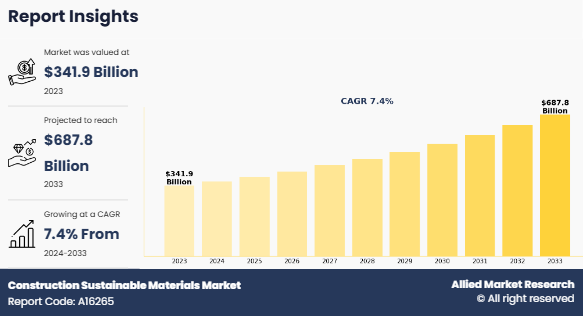
Construction sustainable materials are eco-friendly products used in buildings and construction that are designed to reduce environmental impact throughout their entire lifecycle. These materials are sourced, produced, and utilized in ways that conserve natural resources, minimize waste, and reduce energy consumption. The primary objective of construction of sustainable material is to create structures that are not only durable and functional but also environmentally responsible, contributing to a healthier planet. Sustainable materials include options such as bamboo, recycled steel, reclaimed wood, hempcrete, and rammed earth, among others. These materials typically offer qualities such as renewability, recyclability, and energy efficiency, supporting green building practices and promoting long-term sustainability.
Key Takeaways
- On the basis of Type, the Structural segment dominated the Construction Sustainable Materials market size in terms of revenue in 2023 and is anticipated to grow at the fastest CAGR during the forecast period.
- On the basis of application, the Insulation segment dominated the Construction Sustainable Materials market sharein terms of revenue in 2023. However, the Framing segment is expected to grow at the fastest CAGR during the forecast period.
- On the basis of end-user, the Building Construction segment dominated the Construction Sustainable Materials market growth in terms of revenue in 2023. However, the Infrastructure segment is anticipated to grow at the fastest CAGR during the forecast period
- Region-wise, Asia-Pacific generated the largest revenue in 2023 and is anticipated to grow at the highest CAGR during the forecast period.
Market Dynamics
Increased adoption of green building practices is a significant driver for the Construction Sustainable Materials Industry. As the construction industry focuses more on sustainability, there is a growing demand for materials that reduce environmental impact, enhance energy efficiency, and lower carbon footprints. Green building certifications, such as LEED and BREEAM, incentivize the use of sustainable materials by promoting energy-efficient and eco[1]friendly construction. This shift is driven by regulatory requirements and rise in consumer demand for healthier, environmentally responsible buildings. By integrating sustainable materials, builders can meet sustainability goals while improving a building's environmental performance. Therefore, the growing emphasis on green building practices is driving the growth of the construction sustainable materials market.
However, high manufacturing costs associated with construction sustainable materials act as a key restraint to their widespread adoption. While these materials offer significant long-term benefits such as energy efficiency and reduced environmental impact, the initial investment required for their production and installation can be much higher compared to traditional building materials. This cost disparity can be a barrier for many construction companies, particularly in cost-sensitive markets or projects with tight budgets. In addition, the complexity involved in sourcing, processing, and certifying sustainable materials adds to the overall expense. As a result, despite the environmental and operational advantages, high upfront costs remain a challenge for broader implementation in the construction industry.
Moreover, rise in consumer demand for eco-friendly products presents a significant opportunity for the construction sustainable materials market. As more individuals and businesses prioritize sustainability, there is rise in expectation for eco-conscious building practices. This shift in consumer preferences drives the construction industry to adopt sustainable materials that align with environmental goals, such as reducing carbon footprints and conserving resources. Consumers are increasingly willing to invest in green buildings and energy-efficient homes, creating a higher demand for products such as recycled materials, low-VOC paints, and energy-efficient insulation. This trend boosts the adoption of sustainable construction materials and encourages innovation and investment in environmentally friendly alternatives, paving the way for future growth in the industry.
Segmental Overview
The Construction Sustainable Materials Industry is segmented on the basis of type, application, end user, and region.
By type, the market is divided into structural and non-structural.
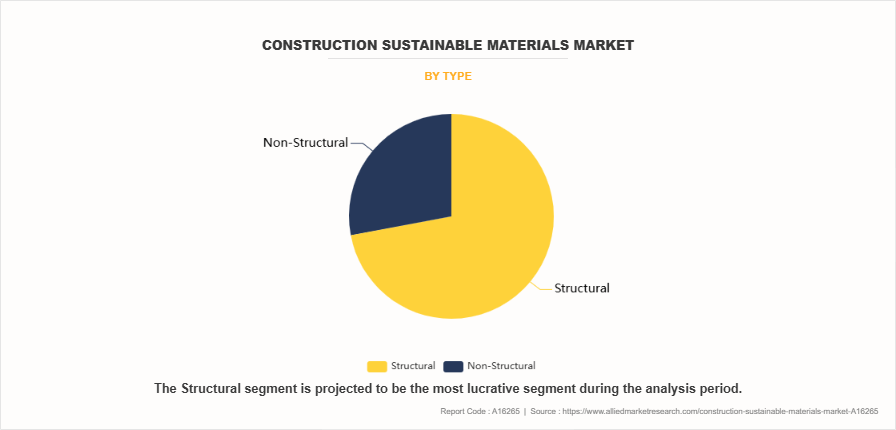
By application, the Construction Sustainable Materials Market Outlook is segmented into insulation, roofing, interior finishing, exterior finishing, and framing.
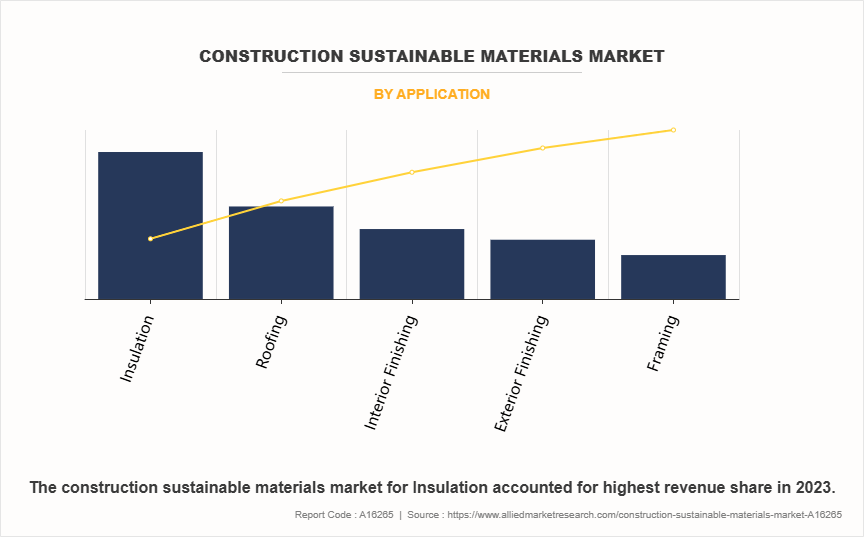
By end user, the Construction Sustainable Materials Market Forecast is classified into building construction, industrial construction, and infrastructure.
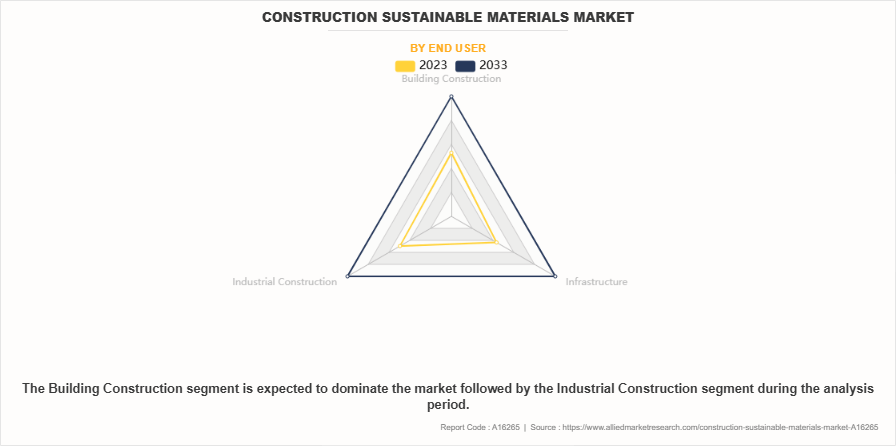
Region-wise, construction sustainable materials market is analyzed across North America (the U.S., Canada, and Mexico), Europe (UK, Germany, France, Italy and rest of Europe), Asia-Pacific (China, Japan, India, South Korea, and rest of Asia-Pacific), and LAMEA (Latin America, the Middle East, and Africa).
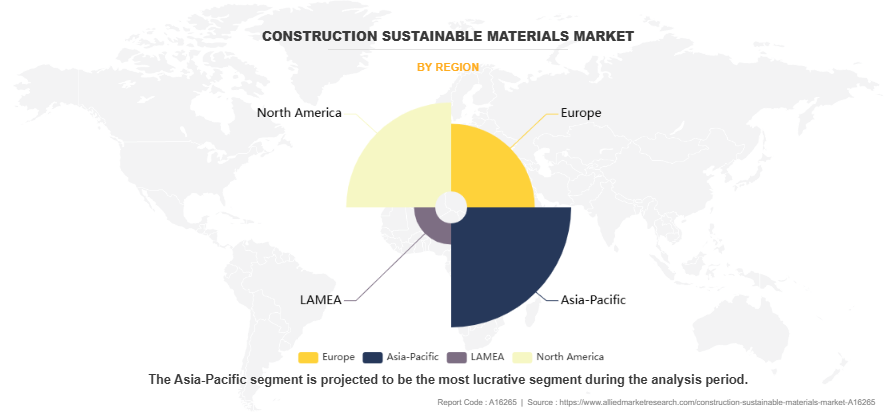
Competitive analysis
Competitive analysis and profiles of the major construction sustainable materials market, such as HOLCIM, Polycor Inc., Ramco Industries Limited, STEICO SE, Greenfiber, Bauder Ltd, Heidelberg Materials AG, Magicrete, Sika AG, and Vulcan Materials Company are provided in this report. Product launch, partnership, expansion, and acquisition business strategies were adopted by major market players in 2023.
Top Impacting Factors
The construction sustainable materials market is expected to witness notable growth owing to growing consumer awareness of environmental impacts and demand for healthier living spaces, drive the adoption of eco-friendly building materials, rising demand for energy-efficient materials to reduce carbon footprints in construction, and government regulations and incentives promoting the use of eco-friendly materials. Moreover, innovations in biodegradable and recycled materials create new growth opportunities for sustainable construction solutions are expected to provide lucrative opportunity for the growth of the market during the forecast period. On the contrary, high initial costs of sustainable materials compared to traditional alternatives limit adoption, particularly in cost-sensitive markets. limits the growth of the construction sustainable materials market.
Key Benefits For Stakeholders
- This report provides a quantitative analysis of the market segments, current trends, estimations, and dynamics of the construction sustainable materials market analysis from 2023 to 2033 to identify the prevailing construction sustainable materials market opportunity.
- The market research is offered along with information related to key drivers, restraints, and opportunities.
- Porter's five forces analysis highlights the potency of buyers and suppliers to enable stakeholders make profit-oriented business decisions and strengthen their supplier-buyer network.
- In-depth analysis of the construction sustainable materials market segmentation assists to determine the prevailing market opportunities.
- Major countries in each region are mapped according to their revenue contribution to the global market.
- Market player positioning facilitates benchmarking and provides a clear understanding of the present position of the market players.
- The report includes the analysis of the regional as well as global construction sustainable materials market trends, Green construction materials, Recycled building materials, key players, market segments, application areas, and market growth strategies.
Construction Sustainable Materials Market Report Highlights
| Aspects | Details |
| Market Size By 2033 | USD 687.8 billion |
| Growth Rate | CAGR of 7.4% |
| Forecast period | 2023 - 2033 |
| Report Pages | 303 |
| By Type |
|
| By Application |
|
| By End User |
|
| By Region |
|
| Key Market Players | Sika AG, Greenfiber, Vulcan Materials Company, Bauder Ltd., HOLCIM, Magicrete, STEICO SE, Heidelberg Materials AG, Polycor Inc., Ramco Industries Limited |
Increased adoption of recycled and bio-based materials, advancements in energy-efficient technologies, and a rise in green building certifications are the upcoming trends of Construction Sustainable Materials Market in the globe
Insulation is the leading application of Construction Sustainable Materials Market
Asia-Pacific is the largest regional market for Construction Sustainable Materials
In 2023, $341.8 billion was the estimated industry size of Construction Sustainable Materials
HOLCIM, Polycor Inc., Ramco Industries Limited, STEICO SE, Greenfiber, Bauder Ltd, Heidelberg Materials AG, Magicrete, Sika AG, Vulcan Materials Company are the top companies to hold the market share in Construction Sustainable Materials
Loading Table Of Content...
Loading Research Methodology...


